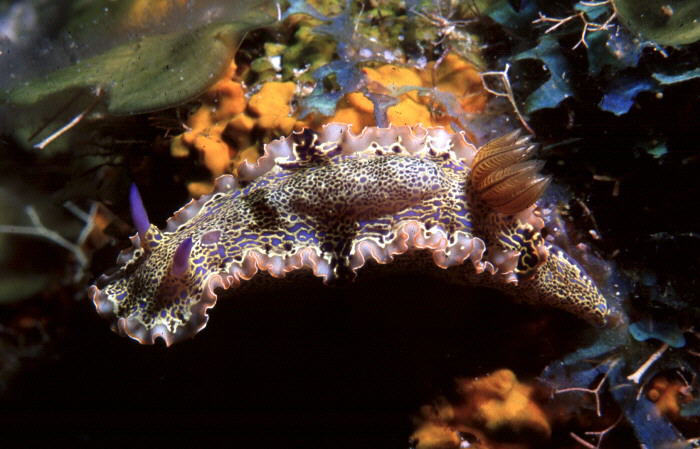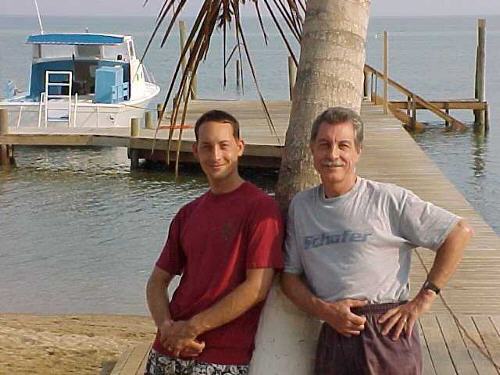 |
Possibly the most beautiful chromodorid nudibranch in the Caribbean, Hypselodoris acriba was really the highlight of our recent trip to Roatan, one of Honduras's Bay Islands. This elegantly colored species is not to be overlooked. The body is blue, covered with a fine yellow-gold mesh pattern. The rhinophores are brilliant purple-blue and the gills are gold. A wide marginal band of white to pink follows the highly ruffled mantle margin. The very edge of the mantle has a thin yellow followed by red line. A series of irregular black spots occurs along the inner edge of the ruffled margin. The yellow mesh network occurs over the tail and hyponotum.
This beautiful species reaches over 60 mm in length, but is considered somewhat uncommon. My son, Michael, found this 40 mm specimen at about 85 feet deep, while diving the shipwreck "The Aquila" on the north side of the island. This particular dive was interesting to us because Hurricane Mitch has rendered this dive site improved by breaking the wreck into three sections exposing more portions of the hull to diver access to see the animal life covering it. You may ask - what effect did Mitch have on the diving in Roatan? I think it's improved from pre-hurricane conditions and Cam & Ted O'Brien, our hosts for the trip will be glad to show you personally. See the Bay Islands Bearch Resort web site for diving opportunities and a Hurricane Mitch Update.
If you want to add a photo of this gorgeous beast to your photo library, Roatan is a great place to look for it, being central within the documented range from Pompano Beach, Florida (see Phil Slosberg's the Cyber Reef) and Puerto Morelos, Quintana Roo, Mexico, at the north end of its range to the Los Rogues Archipelago (east of Bonaire), Venezuela, at the south end.
Like so many of the names the Ernst and Eveline Marcus have given their
species, the derivation of the word "acriba" is unknown. While taxonomists
familiar with their works might suggest, it could be some Brazilian or
Portuguese dialect for a cat or a seal like dozens of their names, my close
circle of friends speculates that it is the product of a little Scrabble
Game - "cariba" for Caribbean, becoming changed to "acriba" with artistic
license. I guess we'll never know. One thing for certain - the animal in
life, is as artistic as its name.
BOW Photo and Text courtesy of Dave and Mike Behrens
Mike and Dave photo compliments of Frank Sebenius

| Michael and Dave Behrens, supported by coconut palm, on the beach of Bay Islands Beach Resort, base camp for their current studies of the coral reef animals of the Honduran Barrier Reef, the world's second largest barrier reef. Mike currently wears two hats, one as a field biologist for TENERA Corporation working at Diablo Canyon Nuclear Power Plant in San Luis Obispo, California, and is a graduate student in the doctoral program in Marine Sciences at University of California at Santa Barbara. Dave is a familiar face on this site and needs no introduction. Their work on Roatan includes photo documentation of the marine invertebrates of Roatan, publication of a Coral Reef Identification guide for this reef system and the development of a snorkeling trail at the Bay Islands resort. |
